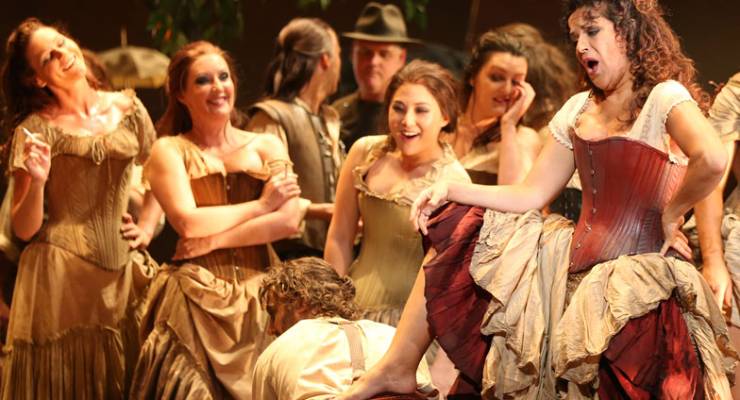
Arts Minister Mitch Fifield has released the National Opera Review. It’s a detailed examination of the health and viability of Australia’s four main stage opera companies: Opera Australia, Opera Queensland, and the Western Australian and South Australian state opera companies. It recommended giving the big opera companies some $24 million. But of course there is no such government cash for the small to medium sector.
The headline recommendation has got the most attention: new funding of $24.14 million over four years, including an increase in core funding for the four companies concerned. There is also a significant commitment to the “artistic vibrancy” of opera in Australia, with the report recommending a new “innovation fund” to support the development of new works.
There is suggested funding for the Opera Conference, and support for touring to regional centres and the bush.
Interestingly, the review also says that Opera Australia should no longer receive funding for popular musicals, arguing that where publicly funded companies are competing in the popular market against commercial promoters, they shouldn’t receive government funding for such activity.
[The real reason George Brandis took so much money out of the arts]
The unsteady financial plight of Opera Queensland is also given due attention. The review recommends a “structural adjustment package” to bail out the northern opera company after a string of losses in recent years.
The background to the review is declining audiences for main stage opera performances since 2009. The review notes that single-ticket main stage audiences for opera performances have shrunk by 21% for Opera Australia and 36% for Opera Queensland; subscriber sales have also fallen.
Total audience numbers of the four companies overall have increased, however, as Opera Australia in particular has filled the gap with popular musicals like The King and I.
The review also recommends that Victorian Opera be given the coveted “golden ticket” of major performing arts status. Review chairperson Helen Nugent told Crikey that the company met all the criteria for being a major company.
“I would describe the review as a comprehensive, fact-based, rigorous document, balanced in the way it tries to meet the needs of the companies as well as responsibilities in respect of external stakeholders including the government,” she said in a phone interview. The aim, she says, is to “put the companies in a position where they can be artistically vibrant, financially viable and also increase access to opera for audiences”.
Nugent was at pains to stipulate what the extra funding was — and was not. “I would not use the word bailout,” she insisted. “Opera Queensland has shown evidence of turning the corner. They’ve been under pressure like the other companies, but they made a small surplus in 2015.”
“They need assistance in making the transition to get their overheads down and their private sector income up, and that’s what they’re being asked to do, and they need some time to restructure their balance sheet.”
[Full list of casualties from Brandis’ arts bloodbath revealed]
But the review’s recommendation for extra funding at a time when smaller companies are struggling after the massive cuts inflicted by George Brandis has already sparked outrage in the broader arts sector.
The Senate inquiry into arts funding established that the small-to-medium sector had nearly double the audience base of the major performing arts companies, of which opera is just one component.
Given the gaping lack of solidarity shown by the major opera companies when the Australia Council funding was cut last year, the broader arts sector is in no mood to support more money for opera now.
[‘Devastating’ OzCo grants just the tip of the iceberg]
National arts advocacy group Free the Arts issued a media release claiming bluntly that the review shows that several opera companies are “insolvent”.
“At a time when small to medium arts companies around Australia are going under and the application success rates for individual artists are at historic lows because of cuts to the Australia Council, this bailout of companies whose audiences are shrinking — in spite of massive government subsidy — looks indefensible,” wrote Free the Arts spokepeople Sarah Moynihan and Norm Horton.
Nugent says the extra funding is to designed to reach more audiences, protect artistic vibrancy and ensure the financial viability of the companies involved. “The core funding amount is based on our assessment of a fair and equitable basis as to what is needed on a activity-based costing model approach to provide for the companies ongoing artistic vitality and their financial viability,” she said.
Nugent is aware that the recommendation for more funding will be controversial in the context of the savage cuts to the Australia Council implemented by former arts minister George Brandis last year. But she insists that questions of funding distribution between art forms and across the arts sector were not part of the review.
“I’m sympathetic to the issues that exist with other major performing arts companies or second-tier and third-tier companies,” she explained. “Having said that, this was not what this review was about.”
“The fact that there is a conclusion that there would be more funding was not predetermined at the outset of this. What the review panel was asked to do was a very specific piece of work, which was to report on these companies. If there’s a need to look at the others, they should be looked at it in a very systematic way.”
Noting the funding difficulties experienced by smaller companies and the national collecting institutions in recent times, Nugent added that she supported increased funding across the arts ecosystem.
Tamara Winikoff from The National Association for the Visual Arts — whose Australia Council funding was slashed last year — questioned why opera was given a review, and not the small-to-medium sector.
“It will be very revealing to see whether the federal government is willing to contemplate sinking even more funding into the opera which already gets the lion’s share of government support,” she told Crikey.
“Another option would be to properly fund the small-to-medium arts organisations, which are the principal support structure for the production and presentation of the artistic expression of who we are as Australians today.”
“However, as a result of federal government cuts to arts funding since 2013, one-third of these small-to-medium arts organisations have lost their operational funding,” Winikoff continued. “In the visual arts it was worst. We lost funding for almost 50% of our arts infrastructure.”
Winikoff pointed out that the small-to-medium sector had in fact asked for a review. “Three years ago, the national peak arts service organisations asked government for a review be undertaken of the health of Australia’s small-to-medium companies. We were told that this was too expensive.”
Leading director and artist David Pledger of public performance group Not Yet It’s Difficult wrote in an email that the funding recommendations were not supportable.
“If last year’s Senate inquiry taught us anything about the Australian arts scene it is that its engine room is the independent arts and small-medium sector,” he wrote.
“It is currently running on empty and any new money should be fuelled there, and not to the artistically moribund and financially decrepit opera sector.”








If the toffs – because let’s be honest, that’s who the LNP are acting for – insist on having their toys and taking them away from everybody else, then it’s about time that they lost theirs too. There should be a protest, and other actions to ruin, every major opera performance until funding is reinstated to the small-medium companies.
$24 million? How many YouTube series or hip-hop albums do we give up each year to get these handful of sonatas, enjoyed by a select few people?
Opera’s a bit like the AFL grand final. A great place to schmooze clients. In any audience sits at least one person who could easily fund the whole operation from their petty cash account. We should force Opera to make these patrons give.
Public Arts funding needs to seek value and reach instead.
I haven’t read the article yet but the headline reminds me of an episode of “Yes Minister” all those decades ago.
Some time ago someone wrote an article at NM which asked this question below[that is the headline and should lead to the article].
“Ever Seen A Drug Dog At The Opera? The Mardi Gras Is A Whole Other Story”
Rather interesting question don’t you think?
I’ll probably be the only one defending Opera, and the other major arts companies, here… like the ABC once was, these are the training grounds for a huge number of people – many, many of whom having trained in the most disciplined and difficult performance forms, go on to be the backbone of other companies. Yes folks, there’s more to Opera/Ballet/large Drama companies than the performers onstage.
That being said – and it’s been said for at least 3 decades – perhaps what we need is one or two of these companies (certainly not more than 2 opera companies) and make sure they tour far and wide (believe me, the touring is the most expensive part – but well worth the effort).